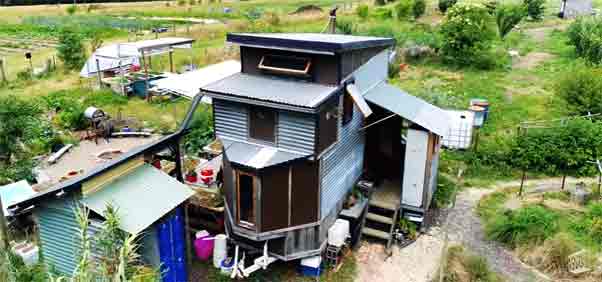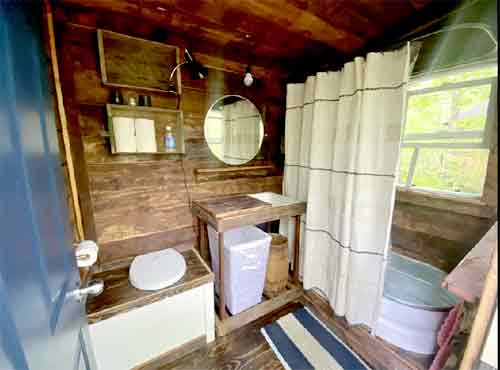Living Off-Grid In A Tiny House
Living off-grid means to not be connected to any public utilities. This includes sewer, water, and electric. It can also mean no internet or any other services delivered like satellite or cable TV. The joys, challenges, and rewards of wilderness living can be yours if you’re willing to work for them. However, as with any project, it’s imperative you start with the knowledge you need to make smart decisions.
Depending on how skilled you are with tools, you can decide if this is the way you want to go. Catching rainwater, growing your own food, creating a solar energy array, and composting your waste is a lot of hard work. Each piece of the puzzle requires it’s own micro-manufacturing system that needs almost constant maintenance. The rewards can be lower energy bills, healthy food, a lower carbon footprint, and the satisfaction of having done it yourself.
Tiny Life Consulting’s Off-Grid Resources and Page Directory
Because we’ve devoted so much research to off-grid living, we decided to create a directory to help you find what you’re looking for more easily. Please visit Off-Grid Resources, Information, and Page Directory for everything you need to start your journey!
Only you can decide how deep a dive you’re willing to take
I tried my hand at gardening several times, only to have my broccoli infested with aphids, my tomato plants disseminated by caterpillars, and my lettuce mowed down by bunnies. Buying food at the grocery store is way easier.
My skill set is electronics and electrical. I can build a reliable solar power system without having to learn this trade, so this is one avenue of off-grid living I can pursue.
What are your areas of expertise? What skills would you be willing to learn? Are you able to put in the physical effort needed?
It’s nice to dream about being total self-dependent like the folks in the video below, but think clearly about your abilities and limitations before jumping in with both feet. Each of us can create our own unique path to our goal of a more sustainable lifestyle.
Composting Yard and Kitchen Waste
Many of my friends compost their kitchen and yard waste. One in particular has created two large areas out of railroad ties, about 4′ square each. He dumps their kitchen scraps and yard clippings into one section, and mixes it with dirt. Once that side is full, he stirs it with a shovel regularly but doesn’t add anymore waste. The second area is then used for fresh waste and dirt until full. By that time, the first bin is usually ready for use in the garden. It can take two or three months for the composting process to complete.
The composter bin shown here is a similar system but on a smaller scale. The Genesis 42 Gal. composter has two chambers. You fill one with scraps and yard waste while the other chamber is completing the composting process. The whole bucket spins to make mixing easier. Finished compost is then dumped out and added to your garden providing natural nutrients.
The composting process uses microbes from the dirt to break down the waste in a fermentation process. It creates a bit of heat and gas. You will need to keep an eye on the moisture content, and keep it out of direct sunlight for best results.
Besides kitchen waste you can compost leaves, grass clippings, weeds and well-rotted chicken manure. Do not add human waste. See my page on composting toilets to see how to handle human waste composting.
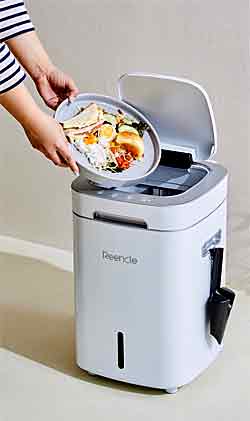
Reencle Microorganism Kitchen Composter
The Reencle Microorganism Kitchen Composter is much smaller-sized to fit in a tiny house kitchen. It saves you from having to run your kitchen waste out to the composter in the yard. In addition, it stirs the compost with the touch of a button. Best of all, the composting process is completed in as little as two hours but not more than about 24 hours!
The fertilizer created from the Reencle Composter can be spread on top of the soil of your lawn, garden, or indoor potted plants, releasing rich nutrients into the soil where it travels directly into the roots of your plants.
Reencle’s technological mechanism emulates the human digestive system. Microbes in your gut digest what you eat. The specific microbe that drives how Reencle works is ReencleMicrobe™, named Bacillus, included in the purchase of the system.
Reencle organic ReencleMicrobe™ is extremely halotolerant and acidophilic, allowing it to work uninterrupted when tasked with breaking down food waste with high levels of salt or acidity. ReencleMicrobe™ is derived from food, it is harmless to the human body and to the environment.
Tiny House Off-Grid Heating
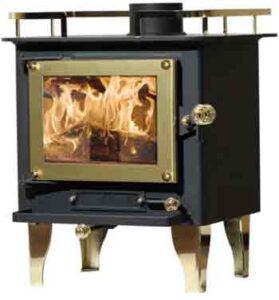
Your home should have at least two ways to heat it. Visit this page for several suggestions on ways to heat your tiny house.
Wood stoves are a great way to heat your off-grid tiny house. However, most wood stoves produce way too much heat. You’ll need a tiny wood stove for a tiny house.
These stunning wood stoves are completely usable as your kitchen stove and oven. They can also be your heater. Click on the picture to learn more.
A wood stove has the added advantage of producing dry heat, which helps with the inevitable moisture problems.
Here is a YouTube® episode of Living Big In A Tiny House about a family that lives off grid:
Permaculture: Living in Cooperation with Nature
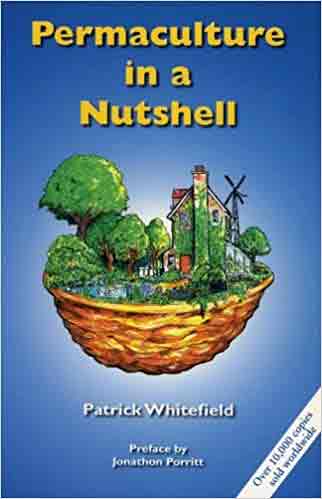
Using the nutrients in your grey water to fertilize your garden, which in turn feeds you, is one example of a “designed environment” that creates an ecologically sound way of living. Keeping bees to pollinate your plants that, in turn, make honey, then feeding the seeds from your plants to chickens producing eggs shows an interconnected system that works in harmony with natural systems.
This inspiring book, Permaculture in a Nutshell clearly describes how we can live fruitfully and sustainably and is essential reading for anyone wishing to reduce their environmental impact. Permaculture in a Nutshell is a concise and accessible introduction to the principles and practice of permaculture in temperate climates. It covers how permaculture works in the city, the country and on the farm and explores ways in which people can work together to recreate real communities.
Tiny House Aquaponics
Aquaponics combines with hydroponics to create a symbiotic relationship between fish and plants.
 Fish waste is transformed by bacteria and circulated with water to the roots of the plants. Fish food is made from composted organic material.
Fish waste is transformed by bacteria and circulated with water to the roots of the plants. Fish food is made from composted organic material.
Aquaponic systems require constant interaction and balancing to remain viable.
Murrary, shown in the YouTube® video above experiments with aquaponics using old bathtubs as a fish tank and grow beds.

The book, shown here, shows all of the details of an aquaponic system. You will need the particular bacteria, also shown here, to begin the biological filtration & nitrogen cycle that turn the fish waste into usable plant food.
Here is a good website if you want to learn more about permaculture.
Aquaponics is still basically an experimental growing technology. The most integral part of permaculture is you making different systems work together.
See another great YouTube® video that shows an Aquaponics system filtering one man’s gray water on this page of this website.
More good books about permaculture, homesteading, and off-grid living.
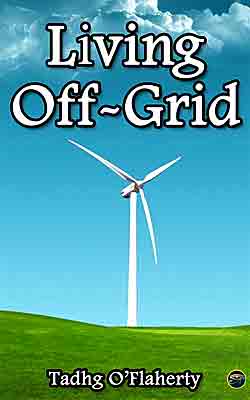
This book is packed with useful tips and tricks that can help you begin with the enjoyment and rewards that come with off-grid living.
One Final Note on Off-Grid Living in a Tiny House or RV
The idea that you just buy a plot of land and plop down a tiny house or RV and your set is misguided.
- 1st: You can’t escape “the man.” There are building codes and zoning laws for your property, I don’t care how remote it is. Read about some defiant folks in Fairplay Colorado.
- 2nd: Homesteading is hard. You need skills and grit to succeed. Not everyone has the skill set needed.
- 3rd: The Off-grid infrastructure doesn’t happen all at once. You need to build it piece by piece. It takes years to get where these folks have gotten.
Learn and Plan first.
Here is a list of The Off Grid Laws In Every State
More pages of this website you’ll want to read
Portable Power Centers How To Choose
Generators or Portable Power Centers: Which One is Right for You?
Portable Inverter Generator Comparison


